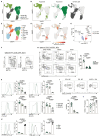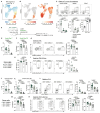Stem-like memory and precursors of exhausted T cells share a common progenitor defined by ID3 expression
- PMID: 39888981
- PMCID: PMC7617396
- DOI: 10.1126/sciimmunol.adn1945
Stem-like memory and precursors of exhausted T cells share a common progenitor defined by ID3 expression
Abstract
Stem-like T cells are attractive immunotherapeutic targets in patients with cancer given their ability to proliferate and differentiate into effector progeny. Thus, identifying T cells with enhanced stemness and understanding their developmental requirements are of broad clinical and therapeutic interest. Here, we demonstrate that during acute infection, the transcriptional regulator inhibitor of DNA binding 3 (ID3) identifies stem-like T cells that are uniquely adapted to generate precursors of exhausted T (Tpex) cells in response to chronic infection or cancer. Expression of ID3 itself enables Tpex cells to sustain T cell responses in chronic infection or cancer, whereas loss of ID3 results in impaired maintenance of CD8 T cell immunity. Furthermore, we demonstrate that interleukin-1 (IL-1) family members, including IL-36β and IL-18, promote the generation of ID3+ T cells that mediate superior tumor control. Overall, we identify ID3 as a common denominator of stem-like T cells in both acute and chronic infections that is specifically required to sustain T cell responses to chronic stimulation.
Conflict of interest statement
R.W.J. receives research support from Roche, BMS, AstraZeneca and MecRx. R.W.J is a scientific consultant and shareholder in MecRx. All other authors declare no competing interests.
Figures








References
Publication types
MeSH terms
Substances
Grants and funding
LinkOut - more resources
Full Text Sources
Molecular Biology Databases
Research Materials
Miscellaneous

